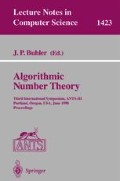Abstract
A Cunningham chain of length k is a finite set of primes p 1, p 2,...,p k such that p i+1=2p i +1, or p i+1=2p i−1 for i=1,2,3, ...,k−1. In this paper we present an algorithm that finds Cunningham chains of the form p i+1=2p i+1 for i=2,3 and a prime p 1. Such a chain of primes were recently shown to be cryptographically significant in solving the problem of Auto-Recoverable Auto-Certifiable Cryptosystems [YY98]. For this application, the primes p 1 and p 2 should be large to provide for a secure enough setting for the discrete log problem. We introduce a number of simple but useful speed-up methods, such as what we call trial remaindering and explain a heuristic algorithm to find such chains. We ran our algorithm on a Pentium 166 MHz machine. We found values for p 1, starting at a value which is 512 bits and ending at a value for p 1 which is 1,376 bits in length. We give some of these values in the appendix. The feasibility of efficiently finding such primes, in turn, enables the system in [YY98] which is a software-based public key system with key recovery (note that every cryptosystem which is suggested for actual use must be checked to insure that its computations are feasible).
Preview
Unable to display preview. Download preview PDF.
References
E. Bach, Explicit bounds for primality testing and related problems. Mathematics of Computation, 55 (1990), 355–380.
J. Brandt, I. Damgard. On generation of probable primes by incremental search. In Advances in Cryptology—CRYPTO '92, pages 358–370, 1992. Springer-Verlag.
E. Bach, J. Schallit. Algorithmic Number Theory — Efficient Algorithms, vol. 1, Chp. 9, 1996. MIT Press.
J. Camenisch, M. Stadler. Efficient Group Signature Schemes for Large Groups. In Advances in Cryptology—CRYPTO '97, pages 410–424, 1997. Springer-Verlag.
T. ElGamal. A Public-Key Cryptosystem and a Signature Scheme Based on Discrete Logaxithms. In Advances in Cryptology—CRYPTO '84, pages 10–18, 1985. Springer-Verlag.
T. Forbes. Prime 15-tuplet. NMBRTHRY Mailing List, March 1997.
Z. Galil, S. Haber, M. Yung. Symmetric public-key encryption. In CRYPTO '85, pages 128–137.
R. Guy. Unsolved Problems in Number Theory. Springer-Verlag, Berlin, 2nd edition, 1994.
N. Koblitz. A course in Number Theory and Cryptography. 2nd edition, 1994. Springer-Verlag.
J. Lacy, D. Mitchell, W. Schell. CryptoLib: Cryptography in Software. AT&T Bell Laboratories, section 2.2.1.
G. Loh. Long chains of nearly doubled primes. Math. Comp., 53, pages 751–759, 1989.
G. Miller. Riemann's hypothesis and tests for primality. In Journal of Computer and System Sciences, vol. 13, pages 300–317, 1976.
S. Micali. Fair Public-Key Cryptosystems. In Advances in Cryptology—CRYPTO '92, pages 113–138, 1992. Springer-Verlag.
M. Rabin. Probabilistic Algorithm for Testing Primality. In volume 12, n. 1 of Journal of Number Theory, pages 128–138, Feb 1980.
K. R. Rosen. Elementary Number Theory and its Applications. 3rd edition, Theorem 8.14, page 295, 1993. Addison Wesley.
R. Solovay, V. Strassen. A fast Monte-Carlo test for primality. In SIAM Journal on Computing, vol. 6, pages 84–85, 1977.
D. Stinson. Cryptography Theory and Practice. Theorem 8.2, page 267, 1995. CRC Press.
A. Young, M. Yung. Auto-Reoverableand Auto-Certifiable Cryptosystems. In Advances in Cryptology—Eurocrypt '98, Springer-Verlag.
Author information
Authors and Affiliations
Editor information
Rights and permissions
Copyright information
© 1998 Springer-Verlag Berlin Heidelberg
About this paper
Cite this paper
Young, A., Yung, M. (1998). Finding length-3 positive Cunningham chains and their cryptographic significance. In: Buhler, J.P. (eds) Algorithmic Number Theory. ANTS 1998. Lecture Notes in Computer Science, vol 1423. Springer, Berlin, Heidelberg. https://doi.org/10.1007/BFb0054869
Download citation
DOI: https://doi.org/10.1007/BFb0054869
Published:
Publisher Name: Springer, Berlin, Heidelberg
Print ISBN: 978-3-540-64657-0
Online ISBN: 978-3-540-69113-6
eBook Packages: Springer Book Archive

